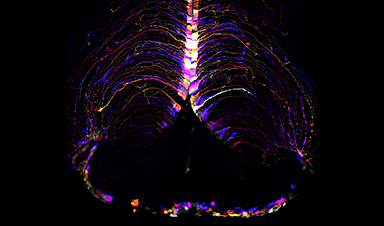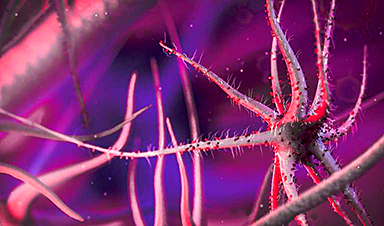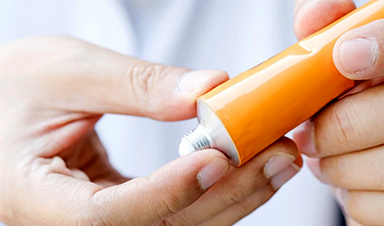As our body ages, not only joints, bones and muscles wear out, but also our nervous system. Nerve cells die, are no longer fully replaced, and the brain shrinks. “Aging is the most important risk factor for Alzheimer’s disease and many other devastating brain diseases,” says Richard Hodes of the National Institutes of Health (NIH). But what exactly happens in our minds as we age, and which parts of the brain age the fastest?
A look into the brains of young and old mice
A team led by Kelly Jin from the Allen Institute for Brain Science in Seattle has now investigated this in more detail. To do this, the neuroscientists compared what happens in the brains of two-month-old “young” and 18-month-old “old” mice. The “old” mice correspond roughly to the brain age of people in older middle age.
The researchers sequenced the RNA of a total of 1.2 million brain cells from 16 brain regions and thus mapped which genes are active in which brain region and which cell types. The tests covered about 35 percent of the entire mouse brain.
Some cells age faster
This showed that some brain cells are more sensitive and age faster than others. In the older mice, these cells showed a significantly different pattern of gene activity than in the young animals, and the contrast was stronger than in other brain cells. In total, around 2,500 genes were more or less active than at a young age, but not equally in all cells.
Most of these sensitive cell types were glial cells, known as the supporting cells of the brain. They do not transmit signals themselves, but support the neurons in transmitting signals through neurotransmitters and support structures. The cells that changed particularly strongly with age included microglia and border-associated macrophages, oligodendrocytes, tanycytes and ependymal cells, as Jin and her colleagues found.
Does altered gene activity promote inflammation and dementia?
It was striking that in these cells in the aging brain, those genes that are associated with inflammation and the immune system as well as the blood vessel cells of the brain were more active. The age-related changes could therefore promote inflammation.
On the other hand, genes related to neuronal structure and function were less active than in young brain cells. This suggests that these cells no longer adequately protect and support neurons, making it easier for neurodegenerative diseases such as dementia to occur.
“Our hypothesis is that these cell types become less efficient at integrating signals,” says Jin. “And this loss of efficiency somehow contributes to what we know as aging in the rest of our bodies.”
Aging hotspot in the hypothalamus
At a certain point in the brain, adjacent to the third ventricle of the hypothalamus, these two effects even occurred together. The third ventricle is an important pipeline through which the cerebrospinal fluid flows, exchanging hormones and nutrients between the hypothalamus and the body. According to the study, there is an aging hotspot in the aging brain where the nerve cells wear out particularly quickly.
At this turntable, the researchers also found cell types with strongly altered gene activity – including tanycytes, ependymal cells and neurons – that are important for nutrient and energy metabolism. Jin and her colleagues conclude that brain aging may also be related to diet and other lifestyle factors such as sleep. Previous studies also suggest that a balanced diet, intermittent fasting or calorie restriction can slow down the aging process of the brain.
Hope for new therapies against aging
“These results provide a very detailed map of which brain cells may be most affected by aging,” Hodes says. “This new map could fundamentally change the way scientists think about how aging affects the brain, and also provides guidance for developing new treatments for age-related brain diseases.”
In particular, the aging hotspot in the hypothalamus is now to be researched in more detail in follow-up studies. Together with the knowledge of which cell types need to be specifically treated, this could lead to the development of new drugs and nutritional strategies that delay the aging process, maintain the function of nerve cells and prevent Alzheimer’s and Co. The knowledge could therefore help to maintain brain health into old age. (Nature, 2025; doi: 10.1038/s41586-024-08350-8)
Sources: Allen Institutes, NIH
News
Novel mRNA therapy curbs antibiotic-resistant infections in preclinical lung models
Researchers at the Icahn School of Medicine at Mount Sinai and collaborators have reported early success with a novel mRNA-based therapy designed to combat antibiotic-resistant bacteria. The findings, published in Nature Biotechnology, show that in [...]
New skin-permeable polymer delivers insulin without needles
A breakthrough zwitterionic polymer slips through the skin’s toughest barriers, carrying insulin deep into tissue and normalizing blood sugar, offering patients a painless alternative to daily injections. A recent study published in the journal Nature examines [...]
Multifunctional Nanogels: A Breakthrough in Antibacterial Strategies
Antibiotic resistance is a growing concern - from human health to crop survival. A new study successfully uses nanogels to target and almost entirely inhibit the bacteria P. Aeruginosa. Recently published in Angewandte Chemie, the study [...]
Nanoflowers rejuvenate old and damaged human cells by replacing their mitochondria
Biomedical researchers at Texas A&M University may have discovered a way to stop or even reverse the decline of cellular energy production—a finding that could have revolutionary effects across medicine. Dr. Akhilesh K. Gaharwar [...]
The Stunning New Push to Protect the Invisible 99% of Life
Scientists worldwide have joined forces to build the first-ever roadmap for conserving Earth’s vast invisible majority—microbes. Their new IUCN Specialist Group reframes conservation by elevating microbial life to the same urgency as plants and [...]
Scientists Find a Way to Help the Brain Clear Alzheimer’s Plaques Naturally
Scientists have discovered that the brain may have a built-in way to fight Alzheimer’s. By activating a protein called Sox9, researchers were able to switch on star-shaped brain cells known as astrocytes and turn them into [...]
Vision can be rebooted in adults with amblyopia, study suggests
Temporarily anesthetizing the retina briefly reverts the activity of the visual system to that observed in early development and enables growth of responses to the amblyopic eye, new research shows. In the common vision [...]
Ultrasound-activated Nanoparticles Kill Liver Cancer and Activate Immune System
A new ultrasound-guided nanotherapy wipes out liver tumors while training the immune system to keep them from coming back. The study, published in Nano Today, introduces a biodegradable nanoparticle system that combines sonodynamic therapy and cell [...]
Magnetic nanoparticles that successfully navigate complex blood vessels may be ready for clinical trials
Every year, 12 million people worldwide suffer a stroke; many die or are permanently impaired. Currently, drugs are administered to dissolve the thrombus that blocks the blood vessel. These drugs spread throughout the entire [...]
Reviving Exhausted T Cells Sparks Powerful Cancer Tumor Elimination
Scientists have discovered how tumors secretly drain the energy from T cells—the immune system’s main cancer fighters—and how blocking that process can bring them back to life. The team found that cancer cells use [...]
Very low LDL-cholesterol correlates to fewer heart problems after stroke
Brigham and Women's Hospital's TIMI Study Group reports that in patients with prior ischemic stroke, very low achieved LDL-cholesterol correlated with fewer major adverse cardiovascular events and fewer recurrent strokes, without an apparent increase [...]
“Great Unified Microscope” Reveals Hidden Micro and Nano Worlds Inside Living Cells
University of Tokyo researchers have created a powerful new microscope that captures both forward- and back-scattered light at once, letting scientists see everything from large cell structures to tiny nanoscale particles in a single shot. Researchers [...]
Breakthrough Alzheimer’s Drug Has a Hidden Problem
Researchers in Japan found that although the Alzheimer’s drug lecanemab successfully removes amyloid plaques from the brain, it does not restore the brain’s waste-clearing system within the first few months of treatment. The study suggests that [...]
Concerning New Research Reveals Colon Cancer Is Skyrocketing in Adults Under 50
Colorectal cancer is striking younger adults at alarming rates, driven by lifestyle and genetic factors. Colorectal cancer (CRC) develops when abnormal cells grow uncontrollably in the colon or rectum, forming tumors that can eventually [...]
Scientists Discover a Natural, Non-Addictive Way To Block Pain That Could Replace Opioids
Scientists have discovered that the body can naturally dull pain through its own localized “benzodiazepine-like” peptides. A groundbreaking study led by a University of Leeds scientist has unveiled new insights into how the body manages pain, [...]
GLP-1 Drugs Like Ozempic Work, but New Research Reveals a Major Catch
Three new Cochrane reviews find evidence that GLP-1 drugs lead to clinically meaningful weight loss, though industry-funded studies raise concerns. Three new reviews from Cochrane have found that GLP-1 medications can lead to significant [...]





















